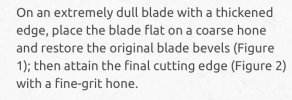View attachment 1343577
This thickening you guys mention is because nobody is sharpening flat grinds correctly. IMHO.
The knife should be laid flat on the stone for a few passes to thin the blade a little with each sharpening.
This also has the added benefit of getting then keeping the blade flat and true. Most knife blades are wavy and have machine marks, that are polished.
The blade you think is perfect is usually far from it. The finish is hiding flaws.
consider the above excerpt from the RMK web site. Instead of waiting for the edge to thicken I give them a few passes each time I sharpen. Similar to how you’d sharpen a Mora, if that helps visualize it.
Most are unwilling to do this. For them the hollow grind makes the most sense.
It sounds crazy, but it really refines the entire blade. Try it on a kitchen pairing knife first and you will see what I mean.
On a side note this is also how I sharpen serated blades. Rub the flat side on the stone. No need to sharpen each seration with a round hone.




